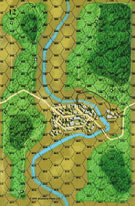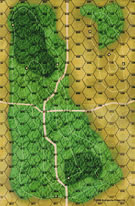| Author |
dricher
(Soviet Union) |
| Method |
Face to Face |
| Victor |
Soviet Union |
| Participants |
unknown
|
| Play Date |
2015-10-29 |
| Language |
English |
| Scenario |
SiFo029
|
In this scenario a well balanced German SS force is attempting to seize a large town from a numerically superior, but poorly balanced, Soviet force of equal morale. The German force contains plenty of infantry supported by machine guns, pioneers, armor, guns, mortars, and healthy OBA. The Soviets have a horde of infantry with reasonable HMG support, a good mortar team, a pair of poor ATGs, and acceptable OBA. The Germans must take the entire town, the Soviets must hold seven town hexes or inflict 20 steps, or confusingly just prevent the German victory and have the draw count as a Soviet victory. Toss that last bit aside and each side has challenging VCs. The smaller German force has a challenge against the numerical superiority coupled with a hard VC, but at least has a force capable of digging out Soviet infantry. The Soviets can suck up losses all day, but may not be able to inflict many steps due to relatively low firepower concentration, so holding seven hexes against higher firepower coupled with sufficient shifts to overcome the town adjustment can be a challenge.
The Soviets set up with most of their force in town hexes, to include all HMGs and mortars, one ATG (right side of town), and 14 units of infantry in the town south of the river, one ATG and one infantry in the town north of the river, and two infantry in support of the north town. There is a Capt plus two infantry in each of the heavy woods east and west of the town. Three stacks of a Lt and two infantry each are on the northern board, one west in the heavy woods, one east in the woods next to the hill, and one in the light woods treeline on the road. All are beyond mortar support, but position is more important than support, so these are expendable forces. The Germans are arrayed to push in the center and on both flanks, keeping their guns back to avoid easy OBA targets.
The Germans immediately envelope the roadblock, but opportunity fire shakes up some Germans in the process. Eventually one Soviet platoon demoralizes and runs all the way back to town, as the other platoon holds for a couple turns before disintegrating, but manages to induce a lot of morale issues in the German center. The German tanks push to the Soviet right, and the Soviets slowly withdrawal. Eventually the German tanks and infantry push the Soviets over the hill, and the mortars move up. The forward Soviet forces eventually get trapped and demolished, but a second line forms in the woods and holds back the German infantry. The German commander notices the setup of the Soviet antitank guns and decides his tanks will do better on his right, and pulls them out and takes a long trip back to the starting line, through the woods, and brings them to his right flank. The German infantry supporting the tanks is not so lucky. They get too close to the Soviet second line and take demoralizing fire. The Soviets then assault the unsupported demoralized infantry and nearly wipe them out. An artillery call on the surviving Germans manages to wipe them out without causing anything stronger than a disruption on the Soviets, who fade into the woods and recover. Eventually this Soviet force recovers and climbs the hill to put the German mortar teams to flight. The counterattack causes the German left to collapse and fall back, eliminating any threat from that side.
On the German right the advance meets the Soviet forward units in the deep woods. While only two platoons in strength, this position becomes the bane of the German force. No matter what firepower the Germans unleash on the position the Soviets suck it up. In tales that will be told for decades, the Germans continuously pound the Soviets who refuse to break, and in fact repeatedly cause losses and demoralizations to the German force. The demoralized units constantly fail and withdrawal as fast as the Germans can move new forces forward. While these two platoons will eventually die, they hold up the entire German advance for a dozen turns, buying the town defenders time to reinforce a second line in the woods to the south. German casualties are mounting nearly as quick as Soviet ones, and half the German force has withdrawn to the starting line to recover. The Germans eventually overcome the epic Soviet resistance, and with tanks a couple turns behind, the German forces begin to stack up in the woods for a rush on the town hex north of the river. The Germans break cover, and the Soviet artillery comes in. An HMG unit vaporizes instantly.
At this point we are running out of time, and need to talk through the rest of the scenario. Losses are nine steps on each side, all infantry with the exception of two steps of German HMG. After fifteen turns the Germans have yet to enter a full hex on the southern board. Soviet town defenses are basically intact, the river line is defended, the German tanks are not yet advancing as they await the demise of the Soviet ATG north of the river (not yet even spotted), and the Soviets are counterattacking on the German left. The Germans are already nearly half way through the game and nearly half way to losing on steps and they have yet to reach spotting distance on a town hex, let alone dig the Soviets out. While stronger in firepower, the disparity in force size has increased since losses are equal. We have no doubt the Germans will take the town north of the river, but are unlikely to achieve victory conditions without unacceptable losses. While we'd both love to play it out, we are forced to quit on time and declare a Soviet victory.
I rate this scenario a 4. Great action and a nice presentation of better force vs larger force. The unbelievable success of a handful of Soviets infantry platoons to hold the Germans so long was very unlikely. The German commander considered going around, but didn't want units in his rear going after the softer guns, so he felt brushing them aside would be easy. It turned into a devastating quagmire. It actually sparked much humor of radio traffic requesting permission to withdrawal, while Commissar Richov kept denying it, insisting they must hold to the last man. The tank pullback actually gave me huge relief, as I feared the Germans would bust through my outer lines and soon be pushing on the town. I think I would have been seriously under the gun if he had reinforced the flank rather than pulling back. The success on both flanks drove him to reconsider pushing on my center, which is where I was best positioned to defend. I think the Germans can win this, but it would not be easy, and they cannot afford to lose time let alone steps. Digging the Soviets out will require the combo of Inf/HMG, Pio, and tanks to overcome town defense, but the Soviets cannot easily inflict steps. Time is the real enemy, and the Germans cannot be only on the north board after fifteen turns. Of course, the German morale is a huge issue in this scenario, and constant demoralization could completely stall any German effort. With a replay, the score may go down to a 3, but I did enjoy the scenario and wished I could have completed it.
|





 SiFo028
SiFo028 



























